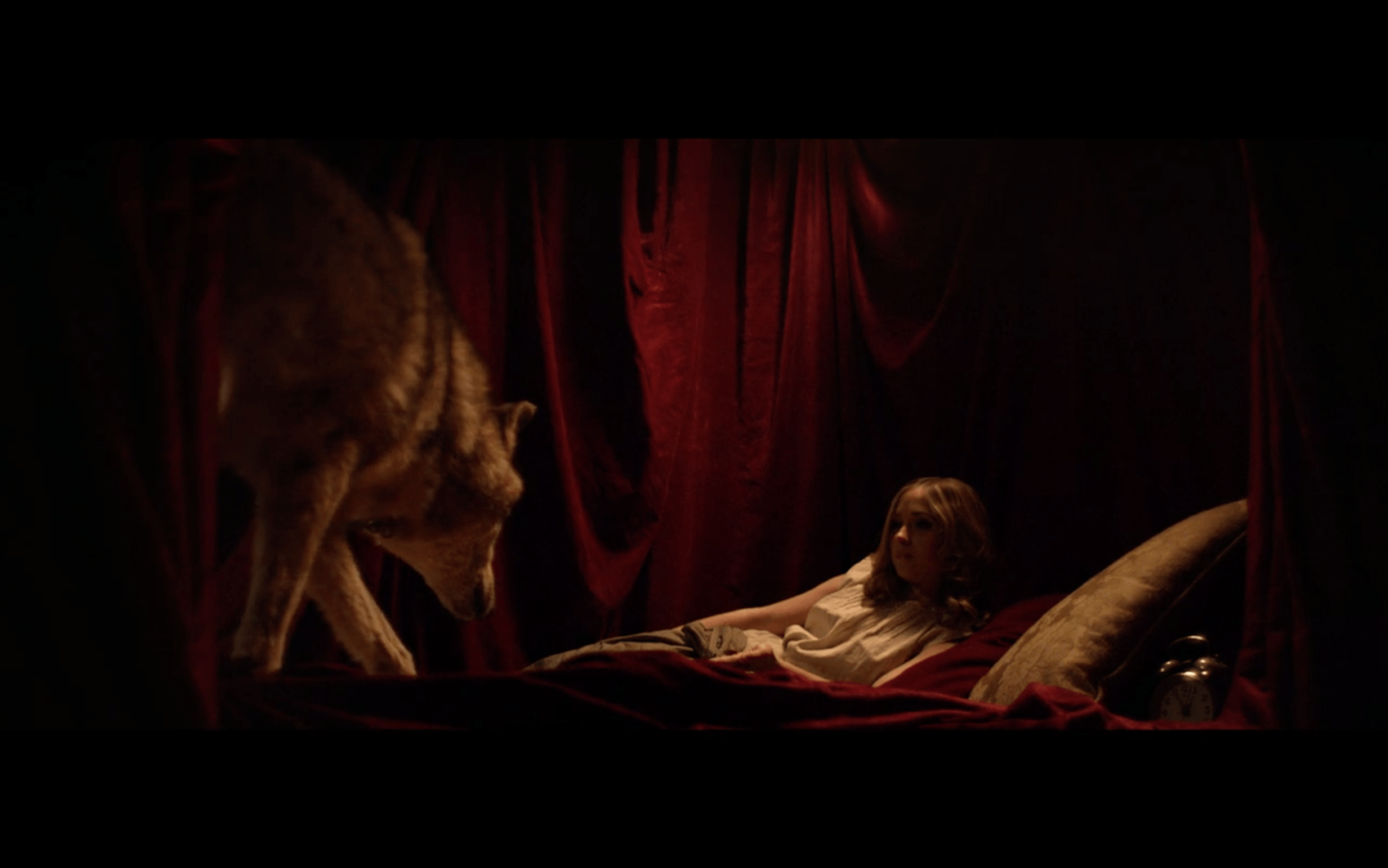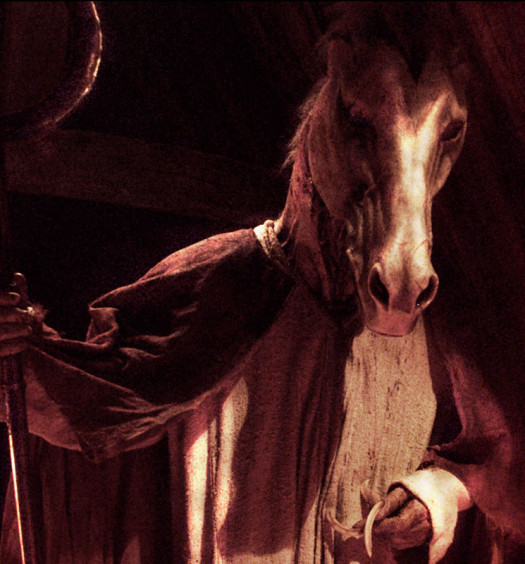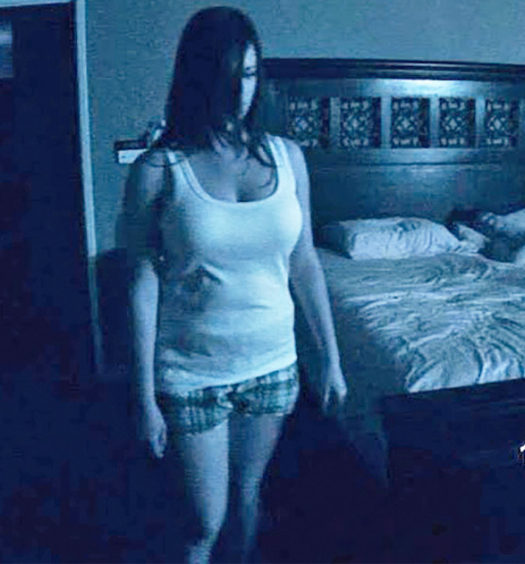The director of last year's mind bender opens up about color, art, and the dreams that led to Horsehead
After watching the dense, beautiful and horrific Horsehead, I felt compelled to learn more about the work that went into this artful exploration of our nightmares. I sat down with co-writer and director Romain Basset over Skype to talk about the film’s many points of reference, from Italian horror to Renaissance art, the film techniques on display in the film, and much, much more.
Basset is an artist in the truest sense; he makes art to help himself and others understand the world around them, and he truly feels for his art. He uses his command of technique to impart that emotional experience to the audience, and does so with refreshing honesty. His experiences with his own nightmares led him to explore the world of dreams, and the emotional resonance of the film’s subject matter to its director is palpable in every frame. Read on for the details of our conversation. It has been lightly edited for brevity and clarity.
So how are you today, Romain?
Oh, fine! I’m leaving for Cannes tomorrow. Horsehead was entered last year, and I really want to bring the new DVDs and Blu-Rays to the meetings there to network for new projects. I’m really proud to get these Blackphone distribution DVDs. Do you have one for yourself?
I’ve actually only watched the film on the screener! I unfortunately don’t have a copy.
Ah, it’s not the same!
I can imagine! The film is beautiful. The photography in it is fantastic and I’d love to see it on Blu-Ray. I’ll buy a copy when they’re available, I’d love to support the project.
I really wanted to thank you for your warm review of my film. It feels really rewarding to read such great words.
Well, Romain, thank you for producing the film. I truly enjoyed it. It’s unlike many other films I’ve watched before; a point of reference that sprang to my mind was Jacob’s Ladder by Adrian Lyne.
Ah! Such a great comparison! I think you really captured the essence of the movie. When you speak about the fact that it’s not really anchored, naturally, unmoored, that the film is difficult to grasp, that is exactly what I intended to do.
I’m glad to hear that. Horsehead is the first film I reviewed for Modern Horrors, and one of the first films I’ve written a formal review of. I’ve read some study on criticism and the goal of it is to ask yourself “what is the movie trying to do,” and to judge it on that merit. I think the film succeeds marvelously in that fact.
Thank you! Thank you, because I’m really disappointed when I’m reading a review in the U.S. of people waiting for a new slasher with a horse-man killing teenagers, which is not at all my movie, you know? It’s not a pure horror film, and when people are waiting for such a movie, I want to say, no, it’s more like an arthouse film, it’s about sensitivity, it’s about a personal experience you have to go through! It’s like a trip. I wanted to make a movie like a bad trip, you know, when you’re hallucinating because of a fever. The film was originally titled Fever, you know, because it was about the illness of this young girl. When you have the peak of fever, you can have visions and nightmares, which is something I experienced back in the day.
I definitely get that feeling. My favorite part of the feel of the film is that you don’t get the context you’re used to in a film. You’re dropped in and you piece it together as you’re watching it, and that’s exactly what a dream is like. You don’t know where you started and you don’t know where you’ll end up, and you’re feeling it as you go along.
That’s why we tried to kill the classical narrative. In the script, the continuity only exists through the symbolism, you know? I consider the sequences of the movie like paintings, like separate paintings in which there is a particular meaning, a particular symbol. This symbol should resonate between them, you know what I mean?
I see that. I gave the film another watch last night and I noticed how the symbols did tie scenes together; there’s a combination of the symbols and the use of color. The color is extremely rich in Horsehead and I think you and Vincent [Viellard-Baron, director of photography] did a great job with the coloring.
Our first goal, because, if you know the budget of the movie, a short film, the film cost $150,000.
Really? It looks astounding for that.
We tried to give the audience the best imagery we could, because I’ve always been a huge horror fan, and I love all the horror cinema; the Italian Giallo, or Argento, this kind of movie. And I think nowadays, in horror, the imagery is not a priority, and it hurts me! What cinema is about to me, I think the image should be the queen of the movie. The image is the priority to me.
One of my favorite things about horror is that the rules are so much looser. It attracts the kind of artist who can put a beautiful image on the screen while portraying something dark at the same time.
This is what I love in horror! The metaphoric power, when you have an image that can be both beautiful and disturbing. It makes…so much sense to me, like in the Cronenberg movies; the power of the imagery is really…it only exists in horror film! That is maybe why it is my favorite genre.
With all that in mind, I’d like to dive into my questions, if you’d like.
Yeah! Yeah, go ahead, man.
My first question is this: what lead you to want to explore dreams in the way Horsehead does? What attracts you to the idea of dreams?
It’s not an idea that I found on my blank page; it came from necessity. I was experiencing at the time the sleep paralysis issues for myself. It was very difficult for me to dream. Do you know the concept of sleep paralysis?
I’m familiar with it; it’s a bit of an ancient phenomenon. It’s where we get the feeling of “the devil on your chest,” right?
Yeah, yeah, exactly. I was in my bed, I couldn’t move at all. I wanted to scream, but no sound could go out of my mouth. It was the most terrific, terrible sensation I have ever endured in my life, this dark…terror. So I did research on the internet, and I came across this magnificent Fuseli painting, you know, and it was supposed to represent this phenomenon of sleep paralysis. Now, I was a huge fan of this painting before, knowing what it was about, and that day when I found it, I found an illustration to this sleep paralysis phenomenon, it was like a new sign. It was echoing what I was feeling. I said to myself “There is a movie that deserves to be made about it.” So here it is! I gathered the idea of a dream as a narrative possibility, and so it became obvious that to tell the story, I would have to find a way to connect the dreams. So here we have lucid dreaming, because I tried lucid dreaming at the time because for me it was like a meaning to cure my sleep paralysis. I thought to myself that maybe if I can control my dreams and my nightmares, maybe I will be cured of these sleep paralysis hallucinations. And it worked!
That’s incredibly interesting to me. The introductory scene when Jessica is experiencing that sleep paralysis takes on a whole new level of power when I hear that personal experience. One of my favorite parts of the film is when that single tear rolls down her face in that scene. It’s very gripping. Was making the film an emotional experience in that way?
In a way, it was like an exorcism. Are you familiar with the concept of catharsis? It was like that. I was shooting with Vincent and my crew, and I got rid of these visions. They went out from my insides. I feel relieved now because it was printed on the film, you know. Well, not printed, because we shot digitally, but, it was in the box! I think it was like a psychiatric experience, like when you’re talking to a shrink and you feel better afterwards. It was the same with my film! Shooting the scenes and my visions; it was like I felt relieved after shooting them.
That’s beautiful. That’s the power of art, isn’t it? Thank you for sharing that with me. We touched on the concept of color earlier, but I would love to delve into it a little bit deeper. What can you tell me about the use of color in the film? The contrast between the deep reds of the nightmares, then you switch to the blue filter in some scenes to great effect. Then the waking scenes are diffused in this golden light. What can you tell me about the interplay between the colors?
Absolutely! Like I was saying earlier, it’s all about giving back to the image; its status as queen or king; the image and sound, the form of the movie was what really I wanted to work on. It’s like in the Cattet-Forzani movie–do you know Amer or The Strange Color of Your Body’s Tears? Do you know those movies?
Unfortunately, I don’t, but if we correspond via email, I’d love to swap notes with you!
Well, they are arthouse films, Strange Color of Your Body’s Tears, it’s a great-written movie. It’s about sensitivity, waking up the audience’s senses. To do that, [a director needs] the power of the image, which needs the frame, and the color. The color was really important to me, because, you know it’s always difficult to feel climate changes or temperatures. You know that we call the color in a shot the “temperature” of it. The cold blue to the warm red. I wanted to give a wide amplitude, is that the word? From very cold, to very hot. That is what I like; the spectrum of color from blue to red and to goldish image. It was supposed also to represent the character’s mental situation at the time. The crucifixion scene, in absolute blue, was very, very cold. People keep talking to me about the cinematic references in the film; for me, it was more like literary references or painting references. I love the symbolism of hearts, the Gustave Moreau painting…giving strong thematics and strong metaphors through the power of a sole image. And that is what I wanted to try myself, since this is my first feature, and to see if I was able to speak with images, and more than with the script or dialogue. As you can see, the script and the classical form of narration is not important to me. If I consider myself as a director, I must show if I have skills to show something with images; yes, that was the main goal.
The film benefits greatly from that approach.
I think one of its greatest strengths and also weakness is that people can feel what I intended to do with the imagery and the way of telling my stories through the echoes of images; on the other hand, some viewers, some of the audience might feel like they don’t get it, that’s all. I can understand perfectly that. It’s not an easy movie, it’s not a movie that will take you by the hand, there is no guide in the movie. It’s really a movie you have to feel. The audience has some work to do! And I like that. It’s like one of Lynch’s movies, when you’re watching Lost Highway, if you are just passive, you are just on the side of the road! You have to get implicated, you have to work as a viewer to resonate your own sensitivity and sensibility.
I think it’s important to buy into a film. You can’t take it on your merits, you have to engage with it on its merits. Horsehead makes you do that. Now that we’re sort of on the topic, I’d like to talk about the film’s themes: the relationship with our parents and the way that affects our psyches. How do those themes reflect your own feelings, or is the film more of an exploration of those topics?
Maybe because I’ve seen the movie, oh, three hundred times, I am able to give so many levels of lecture of rating the movie; but for me, as a writer and director, the movie is about maternity, motherhood, they’re really the main themes of the movie. It’s about relationships between four generations of women in a family: the grandmother, the mother, the daughter, and the daughter inside her. It’s really a feminine movie. It’s about the concept of psychogenealogy: you can reproduce a pattern from your mother or from your grandmother or great-grandmother. The trauma sticks in your DNA. I was really interested in dealing with that; there’s a lot of my own story in it. My tough relationship with my own parents, I think it is. It’s all about motherhood. The symbol of the she-wolf is there, the Capitoline Wolf, referring to the ancient Roman times, the mother of Remus and Romulus, the she-wolf that creates the city of Rome. That’s why there is this Little Red Riding Hood reference in my movie, but, to the contrary, the wolf in my movie is not bad. It is the good side of the she-wolf, and she represents the benevolence of maternity. On the other side, we have the she-horse, the mare as you call it in English. Strangely enough, the painting by Fuseli I was referring is called “The Nightmare,” which etymologically speaking means, you know, the “mare of the night.” So it’s a female horse haunting the night, and that’s where my horse-head comes from. So you have the she-wolf and the she-horse, the mare, the two sides of the same coin, yin and yang; this is where you have symbolism. It’s all about motherhood. That’s why in the movie you can jump-cut from Catelyn (played by Catriona MacColl). In the editing, there is a cut directly referring to the wolf, and in the next cut, you will have the same cut referring to the horse, because the character of Catelyn is very ambiguous, and you don’t get it until the end if she loves her daughter or if she tried to conceal her own past. This is why I was interested in the difficulty of the daughter’s love, how to love your daughter when you have suffered this trauma.
































